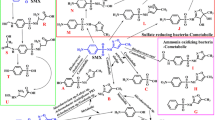Abstract
A novel dye-decolourizing strain of the bacterium Serratia marcescens efficiently decolourized two chemically different dyes Ranocid Fast Blue (RFB) and Procion Brilliant Blue-H-GR (PBB-HGR) belonging respectively to the azo and anthraquinone groups. Extracellular laccase and manganese peroxidase (MnP) activity were detected during dye decolourization. The involvement of MnP activity was found in the decolourization of both dyes. More than 90% decolourization of PBB-HGR and RFB was obtained on days 8 and 5, respectively at 26 °C under static conditions at pH 7.0. MnP activity was increased by the addition of Mn2+ · At 50 μM Mn2+, high MnP (55.3 U/ml) but low laccase activity (8.3 U/ml) was observed. Influence of oxalic acid on MnP activity was also observed.
Similar content being viewed by others
References
Barr, D.P. & Aust, S.D. 1994 Mechanisms white rot fungi use to degrade pollutants. Environmental Science and Technology 28, 79A-87A.
Chang, J. & Lin Y. 2000 Fed-batch bioreactor strategies for microbial decolourization of azo dye using a Pseudomonas luteola strain. Biotechnology Progress 16, 979–985.
Chung, K.T. & Stevens, S.E. Jr. 1993 Decolourization of azo dyes by environmental microorganisms and helminths. Environmental Toxicology and Chemistry 12, 2121–2132.
Green, F., Clausen, C.A., Larsen, M.J. & Highely, T.L. 1995 Induction of polygalacturonase and the formation of oxalic acid by pectin in brown rot fungi. World Journal of Microbiology and Biotechnology 11, 519–524.
Heinfling, A., Martinez, M.J., Martinez, A.T., Bergbauer, M. & Szewzyk, U. 1998 Transformation of industrial dyes by manganese peroxidases from Bjerkandera adusta and Pleurotus eryngii in a manganese-independent reaction. Applied and Environmental Microbiology 64, 2788–2793.
Katagiri, N., Tsutsumi, Y. & Nishida, T. 1995 Correlation of brightening with cumulative enzyme activity related to lignin biodegradation during biobleaching of kraft pulp by white rot fungi in the solid-state fermentation system. Applied and Environmental Microbiology 61, 617–627.
Marmion, D.M. 1991 Handbook of US Colorants, 3rd edn, pp. 573. New York: John Wiley and Sons, Inc. ISBN 0–471–50074–7.
Meyer, U. 1981 Biodegradation of synthetic organic colorants. In Microbial Degradation of Xenobiotics and Recalcitrant Compounds, eds. Leisinger, T., Cook, A.M., Hutter, R. & Nuesch, J. pp. 387–399. London: Academic Press. FEMS Symposium 12, ISBN 0–12–442920–3.
Palmieri, G., Giardina, P., Marzullo, L., Desiderio, B., Nitti, B., Cannio, R. & Sannia, G. 1993 Stability and activity of phenol oxidase from lignolytic fungus Pleurotus osteratus. Applied Microbiology and Biotechnology 39, 632–636.
Pasti-Grigsby, M.B., Paszczynski, A., Goszczynski, S., Crawford, D.L. & Crawford, R.L. 1992 Influence of aromatic substitution patterns on azo dye degradability by Streptomyces spp. and Phanerochaete chrysosporium. Applied and Environmental Microbiology 58, 3605–3613.
Perestelo, F., Falcon, M.A., Carnicero, A., Rodriguez, A. & Da La Fuente, G. 1994 Limited degradation of industrial synthetic and natural lignin by Serratia marcescens. Biotechnology Letters 16(3), 299–302.
Rhoades, T.L., Mikells, A.T., Jr. & Eley, M.H. 1995 Investigation of the lignin-degrading activity of Serratia marcescens: biochemical screening and ultrastructural evidence. Candian Journal of Microbiology 41(7), 592–600.
Rodriguez, E., Pickard, M.A. & Duhalt, R.V. 1999 Industrial dye decolourization by laccases from lignolytic fungi. Current Microbiology 38, 27–32.
Roy, B.P. & Archibald, F. 1993 Effect of kraft pulp and lignin on Trametes versicolor carbon catabolism. Applied and Environmental Microbiology 59, 1855–1863.
Sarnaik, S. & Kanekar, P. 1995 Bioremediation of color of methyl violet and phenol from a dye-industry waste effluent using Pseudomonas sp. isolated from factory soil. Journal of Applied Bacteriology 79, 459–469.
Schiliephake, K. & Langergan, G.T. 1998 Laccase variation during dye decolourization in packed bed bioreactor. Applied and Environmental Microbiology 18, 881–886.
Tien, M. & Krik, T.K. 1988 Lignin peroxidase of Phanerochaete chrysosporium. Methods in Enzymology 161, 238–243.
Verma, P. & Madamwar, D. 2002a Decolourization of synthetic dyes by lignin peroxidase of Phanerochaete chrysosporium. Folia Microbiologica 47, 283–286.
Verma, P. & Madamwar, D. 2002b Production of ligninolytic enzyme by co-cultivation of P.ostreatus and P.chrysosporium and its application towards dyes decolourization. Applied Biochemistry and Biotechnology 102–103, 109–118.
Wang, Y. & Yu, J. 1998 Adsorption and degradation of synthetic dyes on the mycelium of Trametes versicolor. Water Science and Technology 38, 233–238.
Author information
Authors and Affiliations
Rights and permissions
About this article
Cite this article
Verma, P., Madamwar, D. Decolourization of synthetic dyes by a newly isolated strain of Serratia marcescens . World Journal of Microbiology and Biotechnology 19, 615–618 (2003). https://doi.org/10.1023/A:1025115801331
Issue Date:
DOI: https://doi.org/10.1023/A:1025115801331




